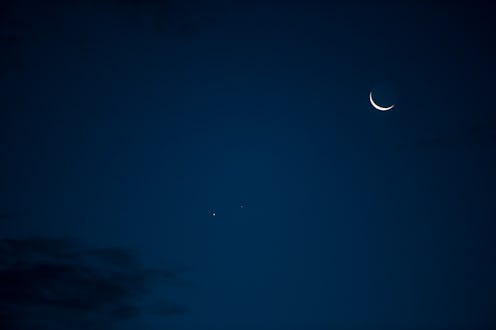Life
When To See The Moon, Mars, & Mercury In A Triangle

Of all the things that you can mark in your calendar for March 29, I'll bet the fact that the Moon, Mars and Mercury will be in a perfect triangle, is the most important. OK, sure, there may be meetings with your boss, appraisals with your manager, hair appointments, Spin classes, laundry, and the small matter of life on earth to attend to. But I guarantee you won't want to miss what happens above your head on March 29 of this year, either. And perhaps in taking time to glance upwards, you'll gain a little more perspective on your day to day, earthly activities? Or not, whatever.
To give you a run-down of what's going on, March is pretty exciting in terms of solar activity. It is our last chance to see Venus rising in the evening sky; the planet can be spotted quickly moving towards the sun each evening, but by March 25 this sight is no more, so catch it while you can. However, as Venus descends, we get the chance to take a peek a Mercury in this month; on March 18 both planets will sit low in the west, just above the horizon at around 8 p.m. And you better prepare yourselves, people, because the sky-show only gets better as the month rolls on.
On March 29, we're in for a real treat: Mars has a date with the moon and the setting sun, along with Mercury. At around 8.30 p.m. on this day you'll be able to see a crescent moon form a stunning triangle with Mercury below and Mars situated above it. If like me, you find it a bit difficult to work out what it is you're looking at, Earthsky recommends using the sliver of moon to locate the other two planets when looking up at the sky. They also recommend looking for "Mercury and Mars to pop out in the vicinity of [March 29]'s moon" and advise using the crescent moon to find the other celestial bodies.
They note, however, that you may require binoculars to spot Mercury, but that the red planet Mars, though smaller and fainter than Mercury, will be easier to find in dusk as it stays present during nighttime. And because Mars is actually at its highest point in nightfall or early evening, you should view it then. If you're in Northern America, Earthsky notes that "Mars will set below your western horizon by early-to-mid evening, at which time you’ll see the king planet Jupiter in the southeast sky." This display is also noteworthy because it includes Mercury, which is usually really hard to spot because it usually gets lost in the brightness of the sun. But as National Geographic notes, this configuration makes for prime Mercury viewing, because it will be at its "brightest and highest".
Sounds like a treat. And anything to distract us from the mania of our busy lives for five minutes is welcomed by me.